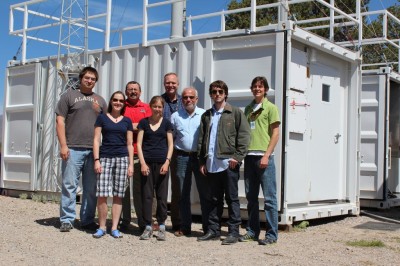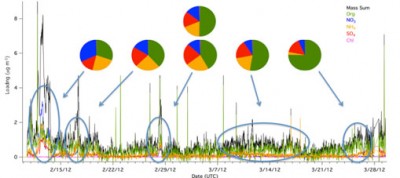
Between December 2011 and April 2012, a research team led by Los Alamos National Laboratory put ARM’s new Mobile Aerosol Observing System (MAOS) to the test, and it passed with flying colors. Building upon previous system integration and operational testing during summer 2011, the primary goal of the Pajarito Aerosol Couplings to Ecosystems, or PACE, field campaign was to demonstrate routine field operations and improve instrumental and operational performance. The MAOS consists of two large shipping containers that house more than two dozen specialized instruments for measuring aerosol, chemistry and trace gases.
The campaign took place primarily at the West Mesa Pinyon-Juniper Woodland site within LANL’s newly renovated Atmosphere, Climate, and Ecosystem Science complex. Because of the area’s existing instrumentation for long-term monitoring of ecosystem, soil, radiation, and hydrological cycle, it was considered ideal for studying the biogenic aerosols produced by mixed conifer forests.
“PACE was the first operational step to expand ARM capabilities for chemistry monitoring with state-of-the art field measurements,” said Dr. Manvendra Dubey, a scientist at LANL and the principal investigator for the campaign. “Though it entailed hard work, it was fun, productive and valuable for the long term.”
Remotely guided by the instrument mentors at Brookhaven National Laboratory, Curt Dvonch led the LANL team in operating the MAOS-Aerosol and Chemistry suite, as well as LANL’s carbon dioxide and isotope instruments. The combination of aerosol and carbon measurements provide details allowing scientists to analyze how ecosystems, fires, and pollution influence aerosols, clouds, and rain in the U.S. Southwest, which is experiencing significant drought and vulnerability to climate change.

Illustrating the nature and variability of aerosols in the study domain, measurements of chemical composition by the MAOS Atmospheric Chemistry Speciation Monitor showed that while the mean composition of aerosols during the period was dominated by organics, episodes of sulfate and nitrate—thought to be from the transport of pollutants into the study domain—showed up in nearly equal proportions. To expand the MAOS-Chemistry suite for studying aerosol formation from forests in future campaigns, scientists are performing carefully designed calibrations and sampling of reactive biogenic organic compounds.
During the course of the campaign, two researchers associated with the ongoing Ganges Valley Aerosol Experiment (GVAX) in India spent nearly nine weeks with PACE researchers at LANL. Because the MAOS did not make the trip to India for GVAX, Dr. Umesh Chandra Dumka from the Aryabhatta Research Institute of Observational Sciences (ARIES) at Nainital and Mr. Ajay S. Nair from the Indian Institute of Science (IISc) at Bangalore joined the PACE team to share and receive additional operational and data analysis experience with the system.
The arrangement proved extremely fruitful, as both groups worked together in tuning the MAOS instruments over a range of conditions and in strengthening the scientific collaboration between the two countries. The MAOS is now in preparation for transport to Cape Cod National Seashore in Massachusetts for the Two-Column Aerosol Project.

